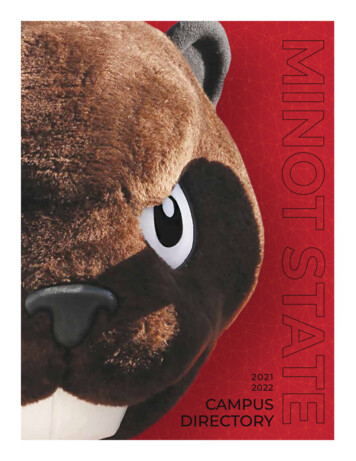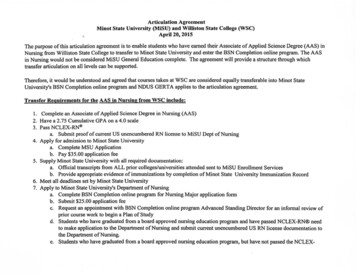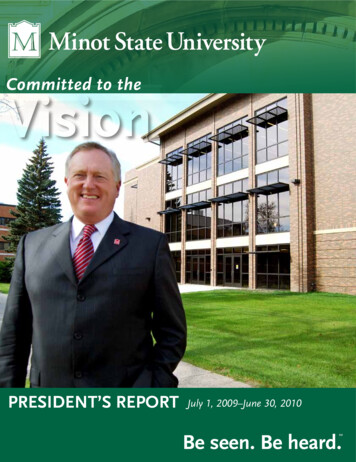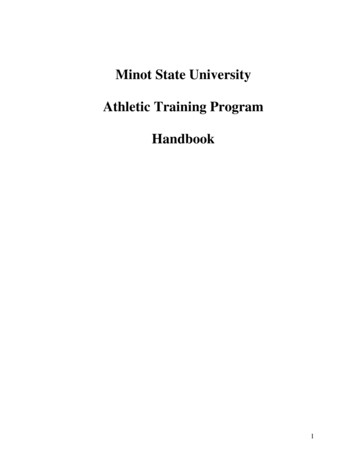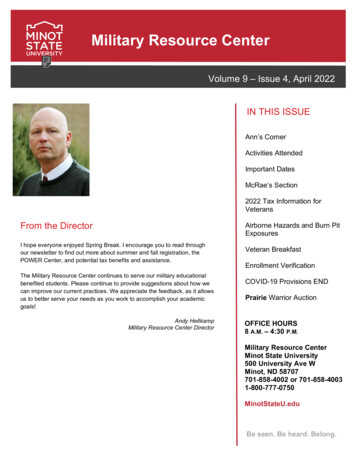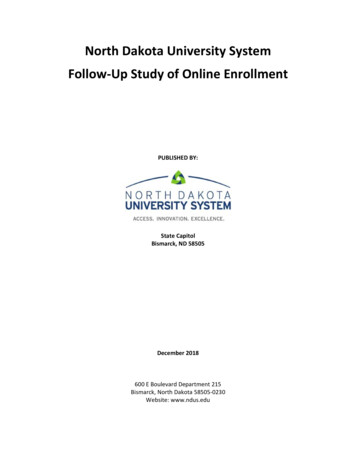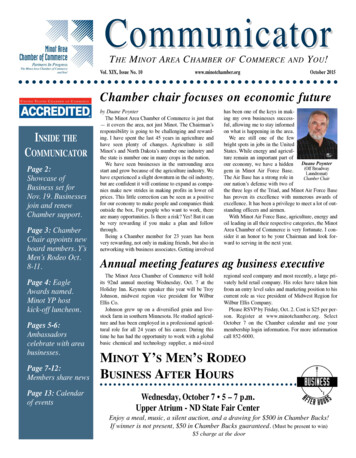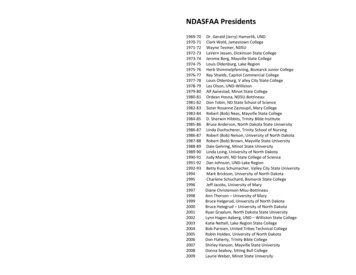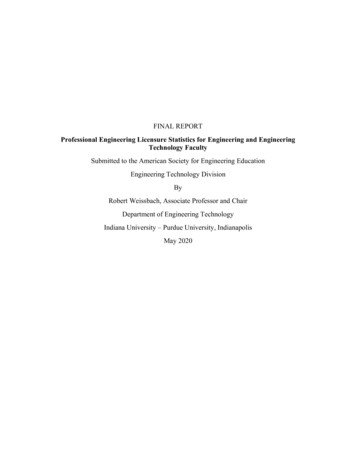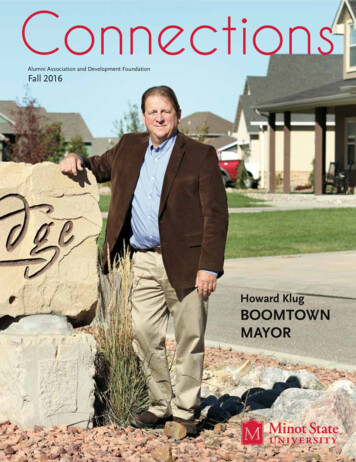
Transcription
ConnectionsAlumni Association and Development FoundationFall 2016Howard KlugBOOMTOWNMAYOR
Message from the Presidentnother academicyear is in fullswing at MinotState University,and it has beena busy semester across campus.The year began with somegood news, as MSU recordedits first increase in overallstudent enrollment in sixyears, and the largest enrollment since 2013. Followingthe devastating flood in Minotfive years ago, the ensuingrecovery, and some otherexternal factors throughoutthe region, the university hasfaced some challenges withstudent enrollment. However,with the efforts of many individuals throughout campusand some new initiatives thepast couple years, we are sopleased to now see these increases. Included in this fall’soverall enrollment numbersare across-the-board increasesin our new student categories(new freshmen, new transferstudents, and new graduatestudents). These are all verypositive signs for the future!Homecoming brought aperfect week of weather withseveral enjoyable reunions,a huge community blockparty, a wonderful day forthe parade and tailgating andmany activities throughout theweek for our students. It wasfun seeing so many alumni andfriends back on campus. I hadconversations with several folkswho had not been at MSUin many years, and they allremarked so positively aboutthe many renovations and upgrades since they last visited.Homecoming Week alsofeatured MSU’s annual GoldenAwards banquet featuringDavid Gowan, Walter PiehlJr., Tom Probst, and Mattand DelRae (Zimmerman)Geinert. A bit later in the fall,we celebrated the annual MSUAthletic Hall of Fame induction recognizing David Blake,Courtney “CoCo” Haley,Melissa Spelchen and the 1992Football Team (featuring agreat turnout of individualmembers from that team!).You can read more about all ofthese very deserving recipientsin this issue of Connections.In August, Minot Stateunveiled its new strategic plan,“Empowering Generations,”along with a new missionstatement and vision for theuniversity. The campus is nowundertaking the importantwork of putting actionableitems in place that will bringthese new strategies to life. Thisis also important work as MSUprepares for its next comprehensive accreditation visit bythe Higher Learning Commission slated for October 2017.A couple of new facesbegan serving in key administrative posts at MSU thisSteven W. Shirley, Ph.D.President2academic year. Dr. LaurieGeller began in June as MSU’svice president for academicaffairs. Laurie has been alongtime professor and chairof mathematics and computerscience at MSU, and shealso previously directed theHonors program. In her newrole, Laurie works closely withMSU’s faculty in the threecolleges, the undergraduate and graduate academicprograms and also coordinatestogether with the other NorthDakota University Systemcampuses. In August, AndyCarter began as MSU’s newdirector of athletics. Andycame to MSU from Northwestern Oklahoma Statewhere he served as AD. Hehas hit the ground runninghelping ensure a smoothtransition from our previousAD Rick Hedberg’s administration (Rick now servesas MSU’s vice president foradvancement).Thanks for your continuedreadership of Connections,and thanks for supportingMinot State University. Pleasestop by the next time youvisit campus. Have a terrificHoliday Season, and I lookforward to seeing you in 2017.As always, GO BEAVERS!
CONNECTIONSVolume 25 — number 1CONNECTIONS STAFFFEATURE ARTICLES481112Howard Klug — Boomtown mayor14Internships provide experiential learning opportunitiesFulfilling a dreamMinot State criminal justice grads protect and serveMSU alum celebrates 100 years Seizing the fast track to success Turning the ordinary into extraordinary1617182022Vice President for Advancement: Rick HedbergManaging Editor and Writer: Alysia HuckWriter and Editor: Frank McCahillWriters: Michael Linnell, Linda Benson ’83/’00Photography Coordinator: Teresa Loftesnes ’07/ ’15Campus Photographer: Richard Heit ’07Publication Design: Doreen WaldAlumni Happenings: Janna McKechnie ’14Baby Beavers: Kate Marshall ’07Class Notes: Bonnie TruebloodIn Memory: Renae Yale ’10GUEST WRITER:Positive experience directs a winding career pathPage 15: Turning the ordinary into theextraordinary — Kristine Zorbaugh ’16ATHLETICSPHOTOGRAPHERS:Minot State announces 2016 Athletics Hall of FameinducteesRichard Heit ’07Michael LinnellJanna McKechnie ’14Summer of changePHOTO CREDITS:Page 8: Frank White Bull — Ta’Sheena FinnPage 8: Mark Henle of The Arizona Republic —Ta’Sheena FinnPage 9: Taté Walker (Miniconjou Lakota) —Ta’Sheena FinnPage 20: Minot Daily News — RiemedioPage 21: Mercyhurst University Athletics —RiemedioRiemedio gets a shot at the big timeDEVELOPMENT FOUNDATIONMaking charitable gifts using your IRA2328ALUMNI HAPPENINGS30CLASS NOTES36IN MEMORY38BABY BEAVERSMSU Alumni Association award recipients announcedConnections is published two times a year by theMinot State University Alumni Association andDevelopment Foundation. Send comments,articles or photo submissions to Connections,MSU Alumni Office, 500 University Ave. West,Minot, ND 58707. Telephone 701-858-3399 or1-800-777-0750. Fax 701-858-3179. Email: alumni@minotstateu.eduPrinted on Forest Stewardship Council certified stock.Third class postage paid at Fargo, ND 58101COVER STORYHoward Klug — Boomtown mayor4Cover Photo:Williston Mayor Howard Klug is focused on the growth of his hometown andenvisions the return of a robust Bakken play, continued population growth anda solid, sustainable infrastructure.3
4
As the mayor ofWilliston, a MinotState grad has beenat the epicenter ofthe Bakken oil boomand its subsequentslowdown. Regardlessof world fluctuations,Howard Klug triesto make positivecontributions, amindset he developedas a co-captain of theMSU Football Teamand leader of SigmaTau Gamma Fraternityin the late 1970s.5
Big Oil arrivesWilliston, Klug’s hometown, has experienced severaloil booms in its recent history.The first occurred in the early1950s when oil was discoveredin the Williston Basin nearTioga. The second arrived inthe early1980s.“Back in the ’80s, it wasall wildcatting,” Klug said.“They’d drill a hole straightdown and hopefully hit oil.”But hit-or-miss drillingproved too dicey for oilcompanies, so they pulled outof the state and fled to morepredictable energy fields.“When the boom quit,the next day there wasno more drilling. It juststopped,” Klug recalled.Williston was left withmillions of dollars in infrastructure debt that wasn’tpaid off until the early 2000s.The region sank into economicand demographic stagnationfor the next two decades.But Big Oil came roaringback in 2007, bringing withit a box of shiny new tools toensure success — hydraulicfracturing, horizontal drillingand pad drilling. “They gotsmarter and smarter and thetechnology got better and better,” Klug said. “Things reallytook off. There was a 99.9percent chance that they weregoing to hit oil.”Soon, more than 200 rigswere drilling in the Bakkenformation, producing over amillion barrels of oil a day.Oil topped 100 per barrel onworld markets.The explosion of drillinghad a major impact onWilliston. Its populationjumped from 12,000 tonearly 40,000 between 2007and 2014. The city’s budgetjumped from 40 millionto 240 million, and itsworkforce went from 90to 240 people. The regionsaw 25,000 jobs created,1,300 businesses launchedand 10,000 apartment unitsbuilt.Klug’s ongoing civic and political involvementderives from a lesson he learned decadesearlier at Minot State.“I was always going to be involved,” he said.“I figured I could contribute in one way orthe other.”Government servicebeginsKlug was serving on theWilliston city commissionwhen the oil boom began. Newdemands quickly stretched thegroup’s bimonthly meetingswell beyond their customaryone-hour limit.“Our meetings were lastingfour to five hours,” Klug said.But Klug wasn’t deterredby the increasing time demandand workload. When longtimemayor Ward Koeser announcedhis retirement in 2014, Klug ranto replace him. He promised todiversify the economy, improvethe quality of life and preserveKoeser’s vision of Williston asthe “best little city in America.”“I knew a lot of people intown that had the same ideasand values that I did,” Klugsaid. “So I ran and won.”To accommodate the needsof a growing population,Williams County and Willistonofficials went on a spendingRepresentatives from Williston’s downtown businesses surround Mayor Klug at a ribbon-cutting ceremony for the Main Street Reconstruction Project(Oct. 2015).6
Williston’s new Area Recreation Center is the activity hub for the greater Williston area.spree. New projects includedthe 77 million Williston AreaRecreation Center, 57 millionhigh school, 55 million jailexpansion and 250 millionairport to replace the currentoverstressed facility.“It was designed for 10,000passengers a year. We were doing that a month,” Klug said.The new mayor learned thatlocal government has to closelymonitor a volatile industry likeBig Energy.“The oil business moves alot faster than government,” hesaid. “We need to provide oversight because there’s so muchmoney out there. There has tobe some checks and balances.”As the Bakken boom piercedthe global consciousness,media organizations descendedon Williston from aroundthe world. Some described adystopian city rife with crime,drugs and vice, backlit by themenacing glow of flaring wells.But Klug rejected that depiction with unvarnished disdain.“We kept hammering atthem that that isn’t the case,that we’ll be just fine,” he said.One French outlet repeatedly challenged the mayor on thehazards of hydraulic fracturing.“I finally stopped talking tothose folks,” he said.The downturn beginsWhen global oil prices began to plummet in late 2014,drilling activity in the Williston Basin slowed considerably. Oil companies shut downoperations, and workers leftthe region. Williston’s population settled at 30,000. Cityofficials welcomed the respiteas an opportunity to reweavethe fabric of their city.“Our infrastructure projectsare getting done on time andunder budget,” Klug said.The mayor, reflecting hisMidwestern optimism, expectsglobal oil prices to climb overthe next year and a half, prompting a resurgence in oil activity.He and other local officialsbase their optimism on a reservoir of 7.4 billion barrels of oilsitting beneath their feet, thelargest deposit of oil and natural gas in the nation. Energyfirms are just biding their time.“They know where the oilis,” Klug said. “They knowhow to drill it economically.They’re ready for when theprice rebounds.”The mayor foresees Willistonbecoming a regional hub,offering educational, medical,retail and transportation services to western North Dakotaand eastern Montana.“Williston will start growing again,” he said “We’rebuilding toward a 50,000population.”The data supports his bullishoutlook. A decade ago, the region saw 150 births a year. Lastyear, the figure was over 900.“We’re becoming a muchyounger town,” he said.“We’re going to be in prettygood shape.”Minot State inspiresWhen Klug entered MinotState in 1975, he planned tomajor in history and minorin business, with hopes of becoming a high school teacherand coach.He played football as afreshman under Coach BertLeidholt. When he droppedout to work on the railroad,Leidholt encouraged him toreturn to school.“He’s the one who kept megoing at Minot State,” Klug said.Klug played center on thefootball team for four years,serving as co-captain his senioryear. He also wrestled underCoach Dean Bachmeier.Appreciating the benefitsof team membership, hejoined Sigma Tau Gamma,a fraternity celebrated for itscharitable projects.He served as the fraternity’spresident for one year and wastwice named its man of the year.The Tri-Sigmas selected him astheir dream man in 1978. Greeklife was a formative experiencefor the Williston native.“You come from a smalltown, and then you interact withpeople from different cultures,”he said. “People taught youthe right way to do things.”Teaching jobs were difficultto find when Klug graduatedin 1980, so he returned toWilliston and entered thehospitality industry. He coowned the El Rancho Hotelfor 35 years.Klug involved himselfin many civic organizationsover the years, including theconvention and visitors bureauand local senior center. Healso enjoyed a long career asa football official, refereeinghigh school and college games.“I was involved Thursdays,Fridays and Saturdays for 25years,” he said.Klug’s ongoing civic andpolitical involvement derivesfrom a lesson he learned decades earlier at Minot State.“I was always going to beinvolved,” he said. “I figuredI could contribute in one wayor the other.” n7
Above: Photo by Frank White BullLeft: Photo by Mark Henle of The Arizona RepublicANIELLE TA’SHEENA FINNknew from the first time sheset eyes on a billboard displaying a beautiful native womanand the words “Home of theFirst-Ever Miss Indian World”that she wanted to be MissIndian World one day.“My father taught at oursister reservation, CheyenneRiver Sioux Tribe, and Ipassed that billboard everyday,” Finn said. “I didn’t knowwhat Miss Indian World8meant, but I saw this beautiful lady in traditional regalia,smiling and happy, anddreamt that someday thatwould be me.”At the age of 25, herdream came true. This wasthe second time Finn ranfor Miss Indian World. Shemade her tribe proud in2014 by winning secondrunner-up. Close to agingout, Finn decided to makeone more attempt in 2016and succeeded. In additionto public speaking and apowwow dance, Finn craftedher own dress, embellishingit with 500 pennies, whichsymbolizes native and nonnative worlds.As Miss Indian World,Finn spends her reigning yeartraveling the world speakingon two important issues inAmerican Indian communities –suicide prevention and languagepreservation.Getting the title, however,took determination, self-confidence and commitment.“I realized as I got olderthat you have to be Miss IndianWorld before you are MissIndian World,” Finn explained.“It takes a whole lot of work,you have to be culturallysound, a good public speaker,and so much more.”Focus on highereducationFinn grew up in Bismarckand in the Porcupine community on the Standing RockIndian Reservation. She attended school in Bismarck andgraduated from Century HighSchool in 2009. While Finnwasn’t certain that she wouldpursue a law career, her familyhad an inkling.“Everyone thought I’d bean attorney from the time I
was a little girl,” Finn said.“I was always good at puzzlesand constantly justifyingeverything I wanted.”Finn started at the University of Nevada-Las Vegas anddecided to study medicine.However, she took one criminal justice class and discoveredher passion. In the midst ofher second year at UNLV, shebecame ill. Finn needed treatment, so she came home. Sheneeded a four-year institutionto complete her degree. Thatis when she discovered MinotState University at BismarckState College. Consideringhow much she enjoyed hercriminal justice class at UNLV,Finn reached out to MelissaSpelchen, director of MSU’scriminal justice program atBSC, to learn how MSU couldhelp her achieve her goal.“I called her last minute tosee if she could help me getaccepted for the spring semester,and I was accepted in twodays,” Finn said. “I wanted sobadly to continue my education. I don’t know how she didit, but she got me organizedand into the classes I needed.MSU was so accommodatingwith everything; everybodywas super helpful.”Still not 100 percentcertain that law was her calling, Finn took classes fromCynthia Feland, South CentralJudicial District judge, and herwavering ceased.“I liked shows like ‘Cops’and ‘Forensic Files,’” Finn said,“but it wasn’t until I met Felandthat I was convinced that wouldbe my calling. There aren’t manynative attorneys, and I knew Icould help people.”Photo by Taté Walker (Miniconjou Lakota)Education was always apriority for Finn. Both herparents earned graduatedegrees. Her mother, BrendaOne Hawk Finn, works inbusiness administration, andher father, John Finn, worksin public health.“My parents were alwaysamazing role models, eventhrough hard times,” Finnsaid. “My mom was gettingher bachelor’s degree while Iwas in high school and hermaster’s while I was gettingmy bachelor’s. It wasn’t easy toput me through college whileshe was attending grad school.They both wanted me to surpass them, which is why I’m ata doctorate level, and I wantmy kids to surpass me.”Making a differenceFinn learned a lot growing up on the Standing RockSioux Reservation. Approximately 100 individuals live inPorcupine today, and Finn isrelated to every one of them,from grandparents to auntsand uncles to distant cousins.“Growing up on thereservation, I saw familymembers overcome so manyhardships,” Finn said. “Fromgenerational poverty totragedy, drugs and alcohol. Isaw what some did that wasnot right, and I learned fromthat. Seeing both roads clearlyhelped guide me.”Finn decided to take it to thenext level. She would not onlylearn from others but also helpthem and make a difference.“I want to better indigenous people, I feel that’s myjob,” Finn said. “It’s who I amas a native woman.”Not only has Finn educated many during her travelsaround the world, but she alsohas been educated, startingwith her semester abroad inIreland while attending MSU.“I earned a minor in international business, so MSU letme go abroad,” Finn said. “Ilearned so much in Ireland!They have many similaritiesto our population, as a peopleimposed on culturally. Therewas a loss of language at onetime. They have special dances,traditions, stories. I reallyidentified with them, and theythought the Native Americanculture was so cool.”One study abroad tripled to many more. While inlaw school, Finn studied inPanama, Mexico, and most recently England. Finn earned acertificate in global arbitrationand practice to complementher Juris Doctorate.“I would definitely creditmy MSU study abroad trip forgiving me the travel bug andsparking my interest in learningin different atmospheres,” Finnsaid. “MSU made studyingabroad so easy and enjoyable.”Reminiscing on the beautiful native woman on the billboard, Finn advises all to searchfor the silver lining, dream bigand focus on the positive. Sowhat might the future hold forMiss Indian World?“I will go back to my tribe,if not now, later, as they supported me so much,” Finnsaid. “The beauty of beingMiss Indian World is I have thechance to demonstrate culturalawareness and diversity andshow how we’ve hung on to itall this time.” n9
Since Minot State University launched North Dakota’s first criminal justiceprogram in 1975, its graduates have honored the university’s long traditionof service by protecting the citizens of the state and beyond. The oil boom andbust brought unprecedented challenges for law enforcement personnel.DARRIK TRUDELLDarrikTrudell,specialagent withHomelandSecurityInvestigations, graduated from MinotState with a bachelor’s degree10in social work in 2002. Upongraduation, he worked forNorth Dakota Departmentof Corrections as a paroleand probation officer for fouryears, then he was a specialagent with the United StatesSecret Service in Philadelphiafor five years. But he and hiswife, Betsy (Vig) ’06, missedthe region’s community spiritand values and wanted tomove back to North Dakota.There is only one Secret Serviceagent in North Dakota, so hechanged agencies and has beenwith HSI since 2011.“HSI investigates a numberof crimes,” Trudell said. “InNorth Dakota, the agencyinvestigates the import orexport of anything across theinternational border and hasimmigration authority. However, the majority of the casesthat we deal with up north arechild exploitation cases, suchas Internet crimes against children, child pornography casesor solicitation of minors.”Trudell also works with thelocal drug task force.“The biggest case I workedhere is a three-and-a-halfyear investigation of a doublemurder for hire case out ofWatford City,” Trudell said.“The criminal killed hisbusiness partner in Spokane,Wash. and his friend inWatford City. He was takento trial and convicted for twolife sentences plus 20 years.”Growing up, the Sidney,Mont., native never wantedto be a police officer or inlaw enforcement. He wantedto coach football, but he gota job at the Dakota Boys andGirls Ranch when he startedcollege, and being a socialwork major coincided withthat. The social work majorgave him an advantage whenhe sought employment withthe North Dakota Department of Corrections inparole and probation.“Probation services is acombination of law enforcement and social work,”Trudell said. “You are dealingwith offenders and their families and seeking services forthem so they don’t re-offend.My social work backgroundgave me an edge. In law enforcement, the ability to talkto people is beneficial.”All of the MSU coachesand Athletics Departmentadministration, such as RickHedberg and Chad McNally,influenced Trudell, whilehe was a student. AndyHeitkamp, former assistant
football coach and currentVeterans Center director, wasthe person who influencedhim the most.“Andy Heitkamp gotme to Minot State, and hehelped me the most,” Trudellrelated. “He always had goodadvice for us no matter whatwas happening in our lives.MSU is lucky to have CoachHeitkamp. My wife and I arepassionate about MSU. It’sbeen good to us.”JASON OLSONJason Olson,Minot chiefof police,graduatedfrom MinotState witha bachelor’sdegree in criminal justicein 1993. Olson began hiscareer with the Minot PoliceDepartment in 1988, and headvanced through the ranks.He was promoted to seniorofficer in 1992 and patrolsergeant in 1997, and then hewas transferred to crime prevention in 2000. In 2004, hewas promoted to lieutenant,assigned to the patrol division night shift. He remainedthere until 2006, when he wasselected to attend the FBI National Academy in Quantico,Va., for management studies.He returned to Minot, andin 2010, he became a captainand took over as supportcommander. He became thechief of police in 2012. TheWilliston native has witnessedtwo oil booms in his lifetime.The latest oil boom broughtunforeseen challenges for lawenforcement officers.“Minot’s populationincreased drastically with theincreased oil activity, and withthat crime increased, especiallyillegal drug activity,” Olsonsaid. “We are dealing with acriminal element that followedthe ‘fast money’ here.”Olson is grateful for thecollaborative relationshipbetween Minot State and theMinot Police Department.“Minot State provides thedepartment with knowledgeable employees, and ourofficers, such as past Minotpolice chiefs Carrol Ericksonand Dan Draovitch, havetaught criminal justice,” Olson said. “In the past, policeofficers have also providedcampus security.”Olson married his highschool sweetheart, Lisa(Nylander) ’89/’06, and theyattended Minot State together.She teaches special educationat TGU Granville and serveson the Minot City Council.MIKE MCGRATHMikeMcGrath,deputychief ofthe U.S.ProbationOfficein North Dakota, earned abachelor’s degree in criminaljustice from Minot State in1998. He continued on to theUniversity of North Dakota toreceive his doctorate in 2014.McGrath holds fondmemories of attending MSU.The connections he made inthe CJ Department’s smallclasses have led to currentworking relationships withformer classmates.“I had very knowledgeable teachers and at the timethat I came into the program,it was one of the premierprograms in the Midwest,”McGrath remembers. “Dr.Gary Rabe, Rural Crime andJustice Center executive director, made the biggest impacton me. He gave me a chanceto branch out. I worked atRCJC, and it gave me someapplied learning. In addition,the people in the CJ Department were connected withlaw enforcement professionalsand that was important withme becoming who I am. Anadjunct professor was a formerfederal probation officer, and itturned me on to the probationcareer option.”As deputy chief, McGrathhandles the operational functions of the federal probationoffice and supervises 35 to 40officers. The office is a growing agency because activity inthe oil industry forced government entities to grow to meetthe demand for services.“I spent a large chunk of mycareer in the Minot office at theheight of the boom,” McGrathsaid. “In my perspective, it hada huge effect on all law enforcement, including federal cases.In fact, the federal governmentmade it a point to assist withlocal law enforcement to ensurecommunity safety.”As far as law enforcementin the future, McGrath envisions law enforcement officersengaging the community tobe more participatory in lawenforcement.11
“Being a probation officertakes a special type of person,”McGrath said. “Someone whoreally understands humannature, law, law enforcement,how to motivate people, andhow to engage families andcommunities. It’s a multidisciplinary, demanding anddynamic job, and that’s whatattracted me to it.”LORI (RODGERS)MALAFALori (Rodgers) Malafa’84/’07 retired from the NorthDakota Highway Patrol in2014 after more than 28 years.She now works for the Department of Transportation as aprogram manager for federalgrant funds funneled to NorthDakota law enforcement12agencies to work traffic safetyprograms.Malafa feels Minot Statehad the best criminal justicedepartment in the state whenshe attended in the 1980s. Sheappreciates that MSU was flexible with her classes while interning with the Ward CountySheriff ’s Department and laterwhen she was on staff.“Dr. David Horton headedthe program,” Malafa said.“He and his wife, Carol Somlo,who was the jail administrator,were very instrumental andinfluential during my collegeyears. I also enjoyed takingclasses from Dan Draovitch,who was a captain with theMinot Police Department atthe same time that he was anadjunct faculty member.”Malafa became the first,and so far only, femalepromoted to sergeant withthe NDHP in 1999 and tocaptain in 2004. She waslater promoted to divisioncommander. While she wasa captain, she served as thetraining director for the LawEnforcement Training Academy in Bismarck. As divisioncommander for seven years,she handled all the agencyhuman resource functions toinclude hiring, transfers, promotions, disciplinary action,grievances, compensation andrisk management. For the lastsix months of her career, shewas division commander forthe western half of the state.In February 2000, shewas conducting a traffic stopon I-94 by Casselton andstanding next to the stoppedvehicle when she was struckby a passing motorist. Thissparked legislation to beintroduced during the 2001legislative session to implement the move-over lawin North Dakota. The lawpassed and went into effectAug. 1, 2001.Law enforcement is a family tradition. Kelly Rodgers’81, her brother and MSUalumnus, encouraged Malafato enter the North DakotaHighway Patrol, as he did.Now retired, he was withNDHP for 27 years. Two ofMalafa’s three sons are NDHPtroopers. Her oldest son,Adam, received a bachelor’sdegree in criminal justice fromNorth Dakota State Universityand is stationed in Fargo. Darin ’15 graduated from MinotState with a CJ degree, and heis stationed in Dickinson.
Of the eight children inher family, four went intothe criminal justice field.One sister, Sandra Rodgers’87 graduated from MSUand worked for the KenmarePolice Department for ashort time before going toFederal U.S. Customs andthen to Federal Immigrationand Naturalization Services.She is no longer employed inlaw enforcement but worksfor the federal government inthe U.S. Department of Labor, where she does employment investigations. Anothersister, Julie (Rodgers) Thompson ’87 also graduated fromMinot State. She worked atthe Bismarck Police Department as an officer/investigatorfor 10 years before joiningthe State of North Dakota.She is still a law enforcementofficer, but she works for theAttorney General’s Office asthe director of security for theLottery Division.Malafa noticed culturalchanges during her yearswith NDHP.“With the increase inpopulation came an increasein traffic, driving violationsand criminal activity,” Malafasaid. “Western North Dakotawas significantly impactedduring the oil boom. Thestate lacked adequate infrastructure to handle the rapidinflux of people and traffic,but it’s better now. Drug arrests and weapons violationsincreased to levels never seenyears ago.”Because of all the occupational prospects in criminaljustice, Malafa encourages students to explore and researchthe possibilities.“In pursuing a career incriminal justice, students shouldtake advantage of internships orride-along opportunities withdifferent agencies,” Malafa said.“Students should explore allof their options so that they candiscover the right fit for themfor long-term careers. Lawenforcement is a challenging,but very rewarding career.”Minot State Universitystill provides an excellentcriminal justice program forits students. Its graduates go onto protect and serve citizens inchanging times. ncirca. 193713
n old soul in ayoung body. That is how manywho know her describe MinotState University finance majorEmily Roark. She knew whatshe wanted early in life andstarted on the fast track to lawschool her sophomore year ofhigh school.“I didn’t want to be incollege for eight years,” Roarksaid. “So I started taking classesthrough MSU the summerbefore my junior year andcontinued up to graduation in2015. I plan to graduate fromMSU in spring 2017.”MSU allows the Bertholdnative ample opportunities tobe involved, as well as closeenough to home to be a part ofher two younger siblings’ lives.She is thankful to have supportive, encouraging parents. Herfather, Michael Roark, inspiredher interest in law. She also hasa keen interest in business.“My dad is a highwaypatrolman, business owner,farmer, really a jack of alltrades,” Roark said. “I wasalways interested in what hewas doing, and law was alwaysinteresting to me, so I decidedto become a business lawyer.”Roark is no stranger tohard work to achieve her goals.Applying as a resident assistantbefore moving onto campus,Roark dove straight intouniversity life.“Bei
Connections is published two times a year by the Minot State University Alumni Association and Development Foundation. Send comments, articles or photo submissions to Connections, MSU Alumni Office, 500 University Ave. West, Minot, ND 58707. Telephone 701-858-3399 or 1-800-777-0750. Fax 701-858-3179. Email: alumni@ minotstateu.edu
